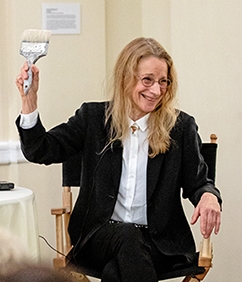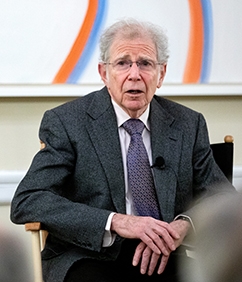NYU Law hosts a discussion of de Kooning’s technique and creativity
The fluid red and blue curves of Willem de Kooning’s The Key and the Parade of 1985 have been a vivid presence in the NYU Law Library since the painting went on display last fall as a loan from The Willem de Kooning Foundation. On February 20, the artwork became the subject and backdrop to a discussion of de Kooning’s technique and artistic vision with artist Joan Levy Hepburn and art historian Richard Shiff. The event was part of the de Kooning Foundation’s ongoing series, de Kooning Conversations.
Dean Trevor Morrison noted in his opening remarks that bringing the painting to the Law School was intended to foster such discussions. “The idea was not just to hang it,” Morrison said, “but to use the arrival of [the painting] here at the school as inspiration for a variety of different kinds of conversations, conversations that don’t necessarily always happen in law schools, but that we want to be part of.”
“Tonight we are focused on insiders,” said Amy Schichtel, executive director of the de Kooning Foundation, as she introduced Levy Hepburn, who was mentored by Willem de Kooning as a young artist, and Shiff, a professor at the University of Texas at Austin who is the author of Between Sense and de Kooning. “Insiders are those who as eyewitness observers offer us firsthand glimpses of de Kooning’s methods, philosophies and character,” Schichtel said. “We hope that understanding a little more about de Kooning may spur new thoughts and vision.”
The comments of both Levy Hepburn and Shiff provided insights into de Kooning’s creative process. Levy Hepburn described de Kooning at work in his studio in Springs, New York, and recounted some of the empirical exercises he would suggest to her rather than stating academic rules of painting. For example, she said, he once gave her the following directions: cover the surface of her canvas with wet white paint; paint with just two or three colors; and finish the painting within an hour.
“So I did it and took it out there to show to him,” Levy Hepburn recalls. “What happens when you paint really fast like that is that your analytical brain cannot keep up with what you are doing intuitively and physically, so it stops and your intuition takes over. And things happen that you wouldn’t have done if you had sat there and thought about it.”
“My personal feeling is he’s never totally abstract,” Shiff said of de Kooning’s work. “There’s always some reference to the body that’s in there. And what’s so remarkable is… if you study de Kooning in relation to his contemporaries, you see that he’s unique in the way that he can turn a line and get it to be as if it were curved and straight at the same time, or seeming to bend one way and an opposite way at the same time. It comes from his observation of the body and the more tricky joints of the body, the shoulders, the elbows, the knees.”
“And in many cases or maybe in all cases, he doesn’t quite know in advance where he’s going, he doesn’t have an idea of a figure that he wants to represent,” Shiff added. “That figure is discovered in the process of making the painting.”
Posted March 10, 2019



